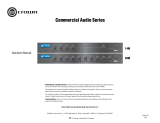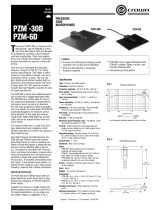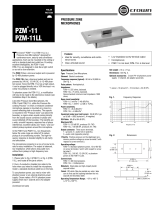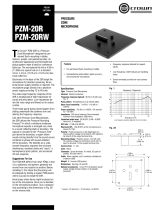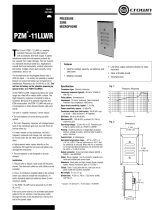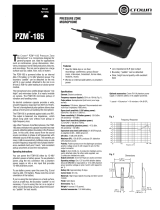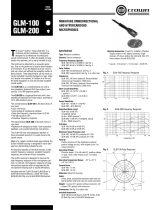Page is loading ...

Low frequencies
High frequencies
Diffuse-Field Frequency Response
Polar Response
STEREO PZM
MICROPHONE
SASS-P MK II
Specifi cations
Type: Stereo condenser.
Element: Electret condenser Pressure Zone Micro-
pohone.
Frequency response (typical): 20 Hz to 18,000 Hz in
a reverberant fi eld. See Fig. 1.
Polar pattern (each channel): Omnidirectional at low
frequencies, unidirectional at high frequencies. See
Fig. 2.
Impedance: 150 ohms rated (240 ohms actual), bal-
anced. Recommended minimum load impedance
1000 ohms.
Open-circuit sensitivity: 6.0 mV/Pa* (–44.5 dB re
1 volt/Pa*).
Power sensitivity: –44 dB re 1 mW/Pa*. –136 dB
EIA.
Equivalent noise level: 20.5 dB SPL typical
(0 dB=.0002 dyne/cm2), A-weighted.
S/N ratio: 73.5 dB at 94 dB SPL.
Maximum SPL: 150 dB SPL at the diaphragm pro-
duces 3% THD.
Polarity: Positive pressure on the diaphragm pro-
duces a positive voltage on pin 2 with respect to
pin 3 of the output connector.
Operating voltage: Standard phantom power, 12 to
48 volts DC, positive voltage on pins 2 and 3 with
respect to pin 1 of the output connector. Or two 9
V alkaline batteries (Mallory Duracell MN1604 or
equivalent).
Current drain: 1.1 mA per channel.
Material: Molded high-impact plastic.
Finish: Satin black and charcoal grey.
Cable: None supplied; use 2-conductor shielded mic
cables.
Connectors: 3-pin professional audio connector (one
per channel).
Switch: Phantom/fl at, phantom/low-cut, battery/fl at,
battery/low-cut. Battery off in phantom positions.
Net weight: 17 ounces (482 grams).
Dimensions: See Fig. 3.
Included Accessories: Handgrip, windscreen,
5/8-in.-27 to 1/4-in.-20 thread adapter.
Fig. 1
Frequency in Hz
Fig. 2
The Crown® SASS-P MK II Stereo Ambi-
ent Sampling System™ is a patented,
stereo condenser microphone using PZM®
technology. It is a mono-compatible, near-coin-
cident array designed for professional applica-
tions including:
classical-music recording (acoustic en-
sembles)
stereo electronic news gathering (E.N.G.)
sports ambience and crowd reaction
recording worship services
televised theatre and dance
fi lm ambience
stereo sampling for keyboards
stereo sound effects
recording studios and live sound
Compared to its predecessor the SASS-P, the
SASS-P MK II provides a warmer, smoother
sound with more high-frequency brilliance
(“air”) and less midrange “hardness.”
A patented design1, the SASS® uses a
premium-quality Pressure Zone Microphone®
for each channel. The PZMs are mounted on
boundaries (with a foam barrier between them)
to make each microphone directional.
The carefully controlled polar patterns and
human-head-sized spacing between capsules
create extremely well-focused, natural stereo
imaging with no “hole in the middle.” Overall,
the reproduction of the sound fi eld is precise
and realistic.
The SASS can accurately convey the ambient
environment for location recording fi lm-wide
sound, or synched audio ambience (movement
of traffi c) where movement heard must precise-
ly match movements in the screen image.
A foam barrier/baffl e between the capsules
shapes the pickup angle of each capsule in the
front, and limits overlap of the two sides at
higher frequencies. Although the mic capsules
are spaced a few centimeters apart, there is
little phase cancellation when both channels are
combined to mono because of the shadowing
effect of the baffl e.
The SASS can be powered in the fi eld by two
9V batteries, as well as 12-48V phantom power.
Separate left and right outputs are low-imped-
ance balanced.
*1 pascal = 10 microbars = 10 dynes/cm2 = 94 dB SPL.
1 U.S. Patent #4,658,932, Michael Billingsley,
April 1987.
Features
Perfect for stereo recording of classical music
ensembles, E.N.G., sports ambience, audience
reaction, and sound effects.
Sharp, accurate and spacious imaging.
Mono-compatible.
Lightweight and portable.
Powered by internal 9V batteries or phantom
power.
Low-cut switch reduces rumble.
Includes windscreen, handgrip, swivel stand
adapter, and stand thread adapter.
POLAR
PATTERNS

Crown International, Inc.
1718 W. Mishawaka Rd.
Elkhart, IN 46517-9439
TEL: 574-294-8000
FAX: 574-294-8FAX
www.crownaudio.com
© 2005 Crown Audio®, Inc.
Specifi cations subject to change without prior notice.
Latest information available at www.crownaudio.com.
Stereo Ambient Sampling System is a trademark, and
Crown, Crown Audio, SASS, PZM, and Pressure Zone
Microphone are registered trademarks of Crown Inter-
national.
10/05 126982-5
Fig. 3
Operating Instructions
Using two 2-conductor shielded microphone ca-
bles, plug the microphone into two microphone
inputs in your mixing console or recorder. The
SASS can be powered with 12-to-48 volt phan-
tom power from the console or 9V batteries.
Crown makes an AC-powered phantom power
supply (model PH-4B) for powering up to four
microphones (or two stereo microphones).
To reduce wind noise from air currents or
microphone movement, keep the included wind-
screen on the microphone. Pull the windscreen
over the system from the front, stretching its
edges to snap over each of the four rear corners
of the boundary plates.
Wind noise and rumble from trucks and air-
conditioning can be reduced by switching in
the low-cut fi lter on the rear panel of the micro-
phone.
After use, remember to set the rear panel switch
to PHANTOM to conserve the batteries.
To avoid a “hole in the middle” effect, mike no
closer than 3 feet (0.915 m).
If the perceived stereo spread is too wide,
locate the SASS left and right input channels on
your mixer, and pan them slightly toward center.
The SASS is designed to have fl attest response
in a diffuse, reverberant sound fi eld such as in
a concert hall. In outdoor or semi-anechoic en-
vironments, its response rises at high frequen-
cies. In this case, you might want to cut a few
dB at upper-mid and high frequencies with your
mixer’s equalizers to make the tonal balance
more natural.
Architects’ and Engineers’ Specifi cations
The microphone shall be the Crown SASS-P
MK II or equivalent. The microphone shall be
a stereo PZM type requiring 12 to 48 volts
phantom powering, or two internal 9V batter-
ies. A smooth frequency response from 20 Hz
to 18,000 Hz shall be obtained in a reverber-
ant fi eld. The polar pattern for each channel
shall be omnidirectional at low frequencies
and unidirectional at high frequencies. Stereo
imaging shall be formed by a combination of
time differences between channels (caused by
spacing the mic capsules) and spectral differ-
ences between channels (caused by angling
directional microphone boundaries apart). A
foam barrier between capsules shall make the
unit mono compatible.
The microphone shall have a sensitivity of 6.0
mV/Pa*. The microphone shall accept a 150
dB SPL input while providing no greater than
3% THD typical. The Crown SASS-P MK II
microphone is specifi ed.
Warranty
Crown professional microphones are guar-
anteed against malfunction for a period of
three years from date of original purchase.
See enclosed warranty sheet for additional
information.
Service
If the unit fails to work, fi rst replace or repair
the mic cables, check batteries, and check the
power supply. A Service Return Authorization
(SRA) is required for product being sent to the
factory for service. An SRA can be completed
on line at www.crownaudio.com/support/fact-
serv.htm. If service is required, return the
microphone and the electronic interface in the
original packaging to Crown Factory Service,
1718 West Mishawaka Road, Elkhart, IN
46517. For further assistance or technical
support call 800-342-6939.
For more information on how the SASS
works and how to use it, please see the
Crown Boundary Microphone Applica-
tion Guide, available free from your dealer,
directly from Crown, or online at
www.crownaudio.com > Microphones >
Document Libary.
For detailed information on SASS theory
and applications, the following papers are
available for a fee from the Audio Engineer-
ing Society:
Preprints 2788 (A-1), 2701 (A-2),
2870 (FD-3).
Audio Engineering Society
60 W. 42nd Street
New York, NY 10165
www.aes.org
SASS-P MK II
/
